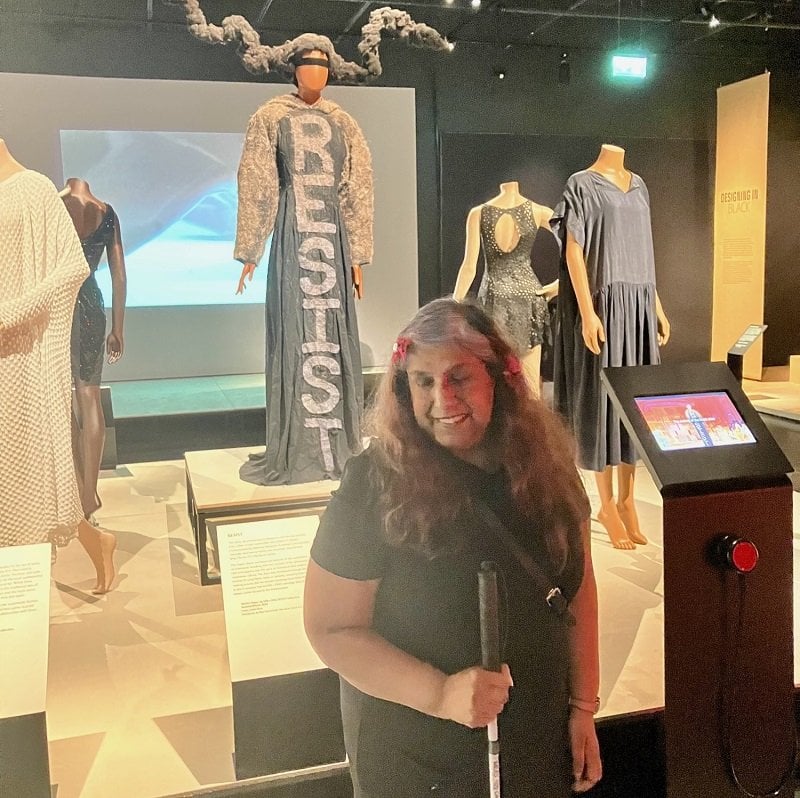National Museum of Scotland in Edinburgh hosted an Audio Described tour of their exhibition ‘Beyond The Little Black Dress’
The exhibition explores how the little black dress by fashion designer Coco Chanel has changed over time and impacted fashion and culture, from punk and afro-futurist fashions to pieces from hit TV show Killing Eve.

Audio Described tours allow visitors with sight loss to experience museums and galleries with greater accessibility and enjoyment.
Kirin Saeed, a Disability Consultant and Actor, says:
“For a visually impaired person like myself, the Little Black Dress exhibition is really brilliant. You know anything else you put with a black dress will match because everything can match with the black. It also has that kind of image of feeling sensational and a having lovely evening out, while also being comfortable. So, I was really excited to find out about the whole adventure of why the little black dress came about.
“I think all exhibitions should do an Audio Described tour or at least have a handling box or handling collection, so people can walk around and feel bits of material or what the artist has made the object out of. It brings it to life and makes the whole experience much more exciting, fun and warm and you learn a lot more about the information they’re sharing.
“I think the museum staff learned a lot from doing the Audio Described tour together, as opposed to just sharing bits of information you can read from a plaque. They were having to do a bit of research, think things through and describe the dresses which highlighted the great simplicity of some of the designs.”
Amelia Hilton, a Content Producer at RNIB Connect Radio, says:
“This is the first Audio Described tour I’ve ever attended, and I absolutely loved it! It was brilliant to pay attention to and discuss the differences in colour and variety of shapes, materials and patterns the designers had used. Listening to the Audio Description of how the exhibition had been presented and organised really helped me understand the themes and the history of the Little Black Dress.
“The touch objects were really useful for understanding how designers wanted the wearers to feel when they had the outfits on, and it was so special to see the original Chanel dress and feel the material of such an important element of fashion history.
“Sometimes people think people with sight loss don’t enjoy or care about fashion, which is so far from the truth - on our radio station we talk to lots of people who love and create fashion, and who take a lot of pride in how they look. I’m so glad the 20th anniversary has helped us break down myths like this and helped us showcase some of the awesome skills and interests blind and partially sighted people have.”
* The ‘Beyond the Little Black Dress’ exhibition runs until October 29, and tickets are available on the National Museum of Scotland’s website: Beyond the Little Black Dress (nms.ac.uk)
Kirin Saeed is a disability consultant focusing on access to museums, galleries, heritage sites and theatres. She provides support and advice on independent living, and is a professional actor, playwright and founder of Visually Impaired Creators of Scotland (VICS).
About RNIB
We are the Royal National Institute of Blind People (RNIB).
Every six minutes, someone in the UK begins to lose their sight. RNIB is taking a stand against exclusion, inequality, and isolation to create a world without barriers where people with sight loss can lead full lives. A different world where society values blind and partially sighted people not for the disabilities they’ve overcome, but for the people they are.
RNIB. See differently.
Anyone facing a diagnosis of sight loss or changes to their condition is encouraged to reach out to the ECLO service and RNIB for support.
Call the RNIB Helpline on 0303 123 9999 or visit www.rnib.org.uk
For further information, please contact Rory Paterson at RNIB Scotland on [email protected].







